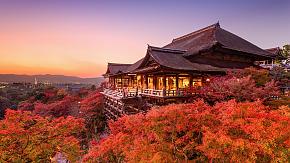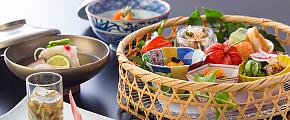Kyoto Travel Guide: How to Explore Japan's Capital of Culture
While Tokyo is the epitome of Japan's modernity, Kyoto shows its traditional side, well-protected by history, with traditional architecture, customs, and lifestyles alive and fresh. For a number of very good reasons, Kyoto is always worth a stop on a Japan tour. If you are curious to find out more, follow this Kyoto travel guide to find out.
Why Travel to Kyoto
From kaiseki cuisine to kabuki shows, as the millennia-old cultural capital that gave birth to the various charms of Japan, Kyoto is the city endorsement of Japanese elegance, where you can capture the most classic side of Japan.
Vermilion pagoda framed by pink and white cherry blossoms, kimono-clad geisha gracefully strolling through streets lined with wooden buildings, and endless torii gates leading through serene forests, no wonder a top destination for first-time visitors, especially for culture and history enthusiasts to get under the skin of Japan from artistry to spirituality.
 Kyoto Tourist Guide
Kyoto Tourist Guide
Things to Do in Kyoto
Traditional Experience in Gion
For some authentic cultural experiences in Kyoto, Gion is the perfect place to immerse yourself. Try the quintessential geisha transformation, complete with kimono dressing and special makeup, then wander through this historic district. Experience a traditional tea ceremony, savoring the rich, bitter taste of matcha, or indulge in a delicate kaiseki dinner within a serene rock garden, enhanced by a captivating geisha performance. Gion truly offers one of the best opportunities to embrace the traditional essence of Japan.
 Maiko in Gion, Kyoto
Maiko in Gion, Kyoto
Ninja & Samurai Transform
The Ninja & Samurai Museum in Kyoto is a must-visit destination to bring your samurai dreams to life. Explore fascinating exhibits featuring shuriken (ninja stars) and katana (Japanese swords), and enjoy interactive experiences like dressing in samurai armor or kimono, practicing sword drawing and swinging, or competing in ninja star throwing. For a deeper dive into this intriguing culture, consider visiting a kendo dojo for an immersive samurai experience.
Admire Japanese Architecture With Sakura & Momiji
The perfect balance between historic architecture and seasonal blooms makes Kyoto particularly enchanting during the cherry blossom and fall foliage seasons, when the city is awash with vibrant colors. Kiyomizu-dera appears to float above a canopy of fiery hues, while the serene gardens surrounding the sacred Nijo Castle glow with fresh light. Arashiyama provides a stunning backdrop for the Togetsukyo Bridge, offering countless photo-worthy moments. Spring and autumn in Kyoto promise unforgettable sights to capture during your visit.
Join the Obon Celebrations
Though Obon, the Japanese Ghost Festival, is celebrated nationwide, Kyoto stands out as the top destination for experiencing it, especially during the spectacular Gozan no Okuribi bonfire event on August 16. This tradition features massive bonfires lit on five mountains, each forming unique shapes like a ship, a torii gate, and the characters "大" (big) and "妙法" (Buddha's remarkable teaching). For the best views, head to elevated spots like Kyoto Tower or the southern areas of the city to take in this mesmerizing cultural display.
Through the Thousands of Torii Gates
One of Kyoto's most iconic sights is the vermilion torii gate tunnel that winds through the forested mountain, leading to the Fushimi Inari Shrine, guarded by its fox messengers. This short hiking experience takes about 2-3 hours to complete the round trip and rewards you with panoramic views of Kyoto. Along the trail, you'll find restaurants offering specialty dishes like kitsune udon (fox udon), a tofu-topped noodle soup said to be favored by the shrine's mythical fox guardians.
 Vermilion Torii Gates at Fushimi Inari Taisha
Vermilion Torii Gates at Fushimi Inari Taisha
How Many Days to Spend in Kyoto
It typically takes 2 to 3 days to cover Kyoto's essential highlights, including central Nijo Castle and the iconic temples and shrines scattered across the city, with enough nighttime to savor an authentic kaiseki meal, unwind in a soothing onsen and a cozy night stroll, providing a glimpse into local traditions.
For those seeking a deeper cultural immersion, a week-long stay is a popular choice, allowing you to explore Kyoto at a leisurely pace with countless experiences. Craft your own cup of matcha, learn a traditional recipe, hone your skills in a kendo competition, or experience the zen spirit during a morning temple visit with monks. Dive into the culture and spirit of Kyoto, uncovering its charms through street food, local interactions, city sightseeing, and glimpses of daily life.
Ways to Get to Kyoto
Although Kyoto has fewer direct international flights, the city is easily accessible thanks to Japan's extensive Shinkansen network, which connects almost the entire country.
How to Go From Tokyo to Kyoto
Upon arriving at Tokyo International Airport, follow the in-app transfer signs to the train station. Take the Keikyu Airport Line to Shinagawa Station, where you can transfer to the Tokaido Shinkansen, one of Japan's most popular routes. In approximately 2 hours, this train line will take you to Kyoto Station.
How to Go From Osaka to Kyoto
If you're starting from Osaka, there are multiple train options available, as well as a direct bus line to central Kyoto, both taking about 1 hour. For a more comfortable and faster option, Odynovo can arrange a private car transfer for a convenient arrival at your hotel.
 Shinkansen Bullet Train
Shinkansen Bullet Train
Popular Day Trips From Kyoto
Nara
The lush forest city of Nara is just a 40-minute train ride from Kyoto, making it an ideal getaway from the bustling city life. Known for Mt. Yoshino, one of Japan's top cherry blossom viewing spots, and Nara Park, where friendly deer roam freely among ancient temples, Nara is a perfect destination for families and animal lovers to enjoy a serene and memorable experience.
Lake Suwa
Located about a 30-minute drive from central Kyoto, Lake Suwa offers a tranquil lakeside retreat, ideal for a leisurely afternoon stroll or a relaxing camping experience near the iconic water torii. Stay overnight if possible to fully immerse yourself in the stunning natural surroundings. Summers are especially magical here, with vibrant fireworks reflecting on the lake during August nights.
Kurama and Kibune
Kurama to Kibune offers a popular 4-kilometer hiking route in the northern hills of Kyoto. This journey takes you through a landscape filled with Tengu statues, Kurama Temple, waterfalls, ancient pine trees, and pathways illuminated by vermilion lanterns. Ideal for a half-day trip, this hike showcases a harmonious blend of nature and culture. And if you hear mysterious echoes along the trail, don't worry, it's just the deer passing by!
Uji
Just a 30-minute drive from Kyoto Station, Uji is a peaceful destination perfect for continuing your exploration of temples and shrines or enjoying its lush greenery along the riverside. Witness the fishing cormorant at dusk or visit the vibrant tea village to sample freshly made green tea. Don't forget to stop by a local tea house for a warm cup of matcha paired with dango (rice dumplings) or yokan (red bean jelly) as a delightful treat.
 Match Pudding at Uji's Tea House
Match Pudding at Uji's Tea House
Kyoto Travel Tips
Avoid Weekend & Holiday
Pick weekday sightseeing in Kyoto, especially during the cherry blossom and fall foliage season. Also, spring break in Japan typically runs from late March (March 25) to early April (April 5), making mid-March or mid-April a good choice to avoid crowds.
Recommended Area to Stay in Kyoto
If you are not sure where to stay during your Kyoto visit, accommodations around Shimogyo Ward are highly recommended, especially around the Kyoto Station. It is one of the most convenient places to get around the whole city as well as the surrounding neighbors for your unexcepted day trip.
Follow the Traditions
As an ancient capital rich in culture and traditions, Kyoto has customs that are still carefully observed. Remember to remove your shoes when entering certain spaces and take a moment to admire the design of your cup before drinking. If you're uncertain about etiquette, following the locals or asking for guidance is always a respectful approach.
Travel to Kyoto With Odynovo
Kyoto is a wonderful city which should not be missed. Visits to Kyoto can be included in any Odynovo custom-made, no-obligation itinerary; just tell us where you want to go or ask for our recommendations and advice. With Odynovo, you decide what your trip shall be; we merely help make your dream trip come true!
Related Posts You May Like
What Our Clients Say
Explore the latest verified reviews of Odynovo's travel services on Tripadvisor, Google, Trustpilot, Product Review and more trusted platforms.













